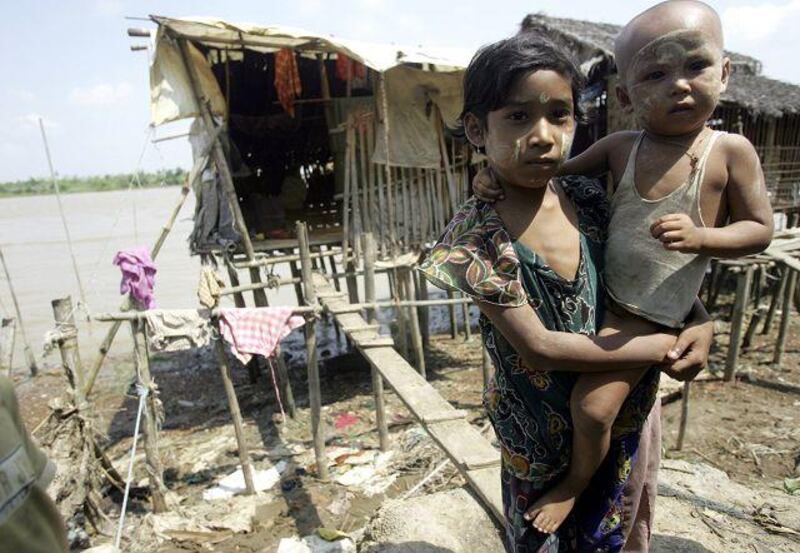BANGKOK // Millions of people who lost everything a year ago when Cyclone Nargis devastated Myanmar's Irrawaddy Delta are still in desperate need of food and shelter. Only a fraction of the homes destroyed between April 27 and May 3 last year have been rebuilt and - with monsoon season again approaching - thousands of survivors are still living in makeshift tarpaulin huts. More than 250,000 depend on weekly rice rations handed out by the UN to survive. One of the key problems facing the cyclone victims is unemployment, making it hard to sustain themselves and their families. More than two-thirds of the population in the Delta, 200km from Yangon, were landless farmers who grew rice on small plots they rented, but had to eke out a living as day labourers. Most families have fallen into debt over the past 12 months. "We depend on outside help to survive - the rice ration we get is our main source of food," Kyaw Myint, a farmer in one of the worse affected areas, said by e-mail. "There is no land available for poor farmers like me to cultivate, and anyway I couldn't afford to buy the seeds and fertilisers I would need to farm." Assistance in restoring agricultural production and creating jobs in the Delta is desperately needed at the moment, aid workers say. "The most critical area that needs long-term support is helping survivors to recover their lost livelihoods, which in the Delta area, chiefly means farming and fishing," said James East, the regional spokesman for World Vision, a US-based non-governmental organisation. Last year's rice harvest in the Irrawaddy Delta produced less than half the usual output, disrupted not just by the deaths of so many farmers, but also the loss of more than 300,000 buffalo and cattle, farming implements and seeds. This year's monsoon rice crop is expected to be significantly better, but there is still much to be done. "Aid agencies have been addressing these issues, but the scale of need is very challenging and there continues to be a real need to provide farmers with draft animals for ploughing, or with mechanical tractors," Mr East said. "A good harvest will help kick-start the local economy, enable farmers to rebuild their seed stock for future planting, and create a capital base to buy farm animals and equipment, as well as hire daily wage workers." The growing indebtedness of people in the Delta may prove to be the largest obstacle to recovery. More than four out of five families interviewed by the World Food Programme this year said their household income had decreased substantially since Cyclone Nargis. Over half of all those households said they had been forced to borrow more in the past year, and that this was largely spent on food. The WFP survey carried out in the Delta in February found that 80 per cent of households had had to borrow to buy food. "Although the provision of paddy for cultivating during the rainy season is especially important, many people are in huge debt and don't have the money to invest to ensure they have a good harvest this year," said Luke Arend, the deputy head of Médecins Sans Frontières in Myanmar. The level of debt, in fact, is making long-term recovery in the Delta almost impossible, according to Sean Turnell, an economist at Macquarie University in Australia who specialises in Myanmar. Most of these farmers are forced to turn to loan sharks - as there are no proper banks or financial institutions in Myanmar - who charge exorbitant rates of interest, making it virtually impossible to break out of debt, Mr Turnell said. The UN says recovery in Irrawaddy will take years. "The devastation was vast, and it will take many years before all the 2.4 million severely affected people have recovered fully," Bishow Parajuli, the UN's resident co-ordinator for humanitarian assistance in Myanmar, said. "We know that from comparable natural disasters such as the 2004 Indian Ocean tsunami that the long-term recovery work takes a long time." Aid workers say that difficulty reaching affected areas is hindering their work. "When I was involved in the tsunami recovery efforts in Aceh [Indonesia], we did not face logistics problem as we had many helicopters to reach remote areas. But in Myanmar, it takes long hours to reach some towns," said Bernd Schell, the head of the International Federation of Red Cross and Red Crescent Societies office in Yangon. One Myanmar community volunteer who works in the remotest cyclone-affected area - the central Delta area and the western part along the coast - said there are parts of the Delta that have received little or no assistance. The terrain in much of the Delta makes relief and reconstruction efforts difficult, he said, and some villages on the coast that take days to get to are in desperate need of basic amenities such as food, shelter and water. With the monsoon season approaching, Mr Parajuli, said efforts could be hindered further. "Some villages are very isolated and can only be reached by boats. The rivers are big, the tides are very difficult and the weather - during the monsoon season - can be very dangerous." ljagan@thenational.ae
Still hungry and homeless, a year on
Residents are struggling to meet basic daily needs a year after Cyclone Nargis - and monsoon season is approaching again.

More from the national




